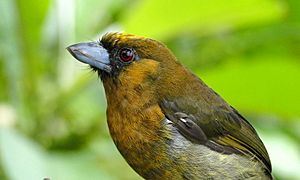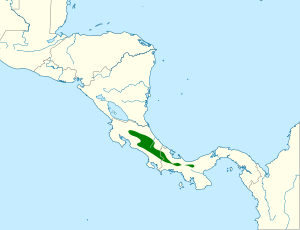Prong-billed barbet facts for kids
Quick facts for kids Prong-billed barbet |
|
|---|---|
 |
|
| Conservation status | |
| Scientific classification | |
| Genus: |
Semnornis
|
| Species: |
frantzii
|
 |
|
The prong-billed barbet (Semnornis frantzii) is a unique bird with a large bill. It lives in the wet, high-up forests of Costa Rica and western Panama.
Contents
Understanding the Prong-billed Barbet's Family Tree
How Scientists Classify Birds
Scientists group living things into families based on how they are related. This is called taxonomy. For a long time, the prong-billed barbet was thought to be part of a big family of birds called Capitonidae, which included barbets from both the Americas and other parts of the world.
A New Family for the Barbet
However, new studies looked at the birds' bodies, how they bred, and their DNA. These studies showed that barbets from the Americas are actually more closely related to toucans than they are to barbets from other continents.
Because of this, scientists created new families for these birds. The prong-billed barbet and its close relative, the toucan barbet, were placed into their own special family called Semnornithidae. This means the prong-billed barbet is the only type of its kind within its species. It was named after a German scientist, Alexander von Frantzius.
What Does the Prong-billed Barbet Look Like?
Size and Bill Features
The prong-billed barbet is about 17 to 18.5 cm (6.7 to 7.3 in) long. It weighs around 60 to 70 grams (2.1 to 2.5 oz). Its bill is a shiny silver-gray or bluish color with a dark tip. The lower part of its bill has a small notch, which gives the bird its "prong-billed" name. The upper part of its bill is hooked and also has a notch on the side.
Feather Colors and Markings
Adult prong-billed barbets have a dull golden-brown crown on their head. Their neck and upper back are brownish-olive. The lower back and tail feathers are olive-green. Males have a shiny black tuft of feathers at the back of their head, but females do not.
Both male and female barbets have dull black areas around their eyes, cheeks, and chin. The sides of their head, neck, and upper chest are a buffy-olive color. This color turns yellowish on their lower chest. Their belly is pale yellow in the middle, and their sides are grayish with a light yellow tint. Their tail is dull green, and their wings are dusky. Young barbets are generally duller in color than adults. Their black face areas are more gray.
Where the Prong-billed Barbet Lives
Geographic Range
The prong-billed barbet lives in the mountains of Costa Rica. Its range extends into western Panama, specifically the Veraguas Province.
Preferred Habitat and Elevation
These birds mostly live in very wet mountain forests. In Costa Rica, they are found between 750 and 2,450 meters (2,460 and 8,040 ft) high on the Caribbean side. On the Pacific side, they live between 1,500 and 1,450 meters (4,920 and 4,760 ft). In Panama, their usual height is between 1,500 and 2,250 meters (4,920 and 7,380 ft). Sometimes, they can be found at slightly lower elevations in both countries.
Their home is a very humid evergreen forest. This type of forest has many epiphytes (plants that grow on other plants) and mosses. It is also often covered in fog.
Prong-billed Barbet Behavior
Movement and Migration
The prong-billed barbet does not migrate. It stays in the same area all year round.
Social Life
When it's not breeding season, prong-billed barbets often look for food in groups. These groups can have up to 12 birds. They also sleep together in tree holes. Up to 16 birds might roost closely together in one cavity.
What They Eat
Prong-billed barbets usually find their food high up in the forest canopy. Sometimes, they will forage lower down at the forest edges. Their diet is almost entirely fruit. However, very young baby barbets are fed insects. They either swallow small fruits whole or squeeze out the inside. For larger fruits, they tear them apart to eat.
Reproduction and Life Cycle
Prong-billed barbets are monogamous, meaning they have one partner. They also protect their territory during the breeding season. This season starts in March when pairs begin to court. They start digging their nest holes in trees around the middle of March.
Nest cavities are usually found between 3 and 18 meters (10 and 59 ft) above the ground. A female barbet will lay four or five eggs. The eggs hatch after 14 to 15 days. Both parents take turns sitting on the eggs. They also both care for the baby birds and young birds after they leave the nest.
Sounds and Calls
The song of the prong-billed barbet is described as a deep "cwa-cwa-cwa-cwa." This sound is repeated many times. It is a loud, clear, and somewhat throaty sound. Both male and female barbets sing, often together in a duet. Sometimes, several birds will sing in a "chorus."
They also make different calls. These include low, dry rattling sounds. They can make a nasal, squalling "kwaaaah" sound. Other calls are a "skurr," bark-like "chuk" notes, and an alarm cackle.
Status and Conservation
Current Population Status
The IUCN (International Union for Conservation of Nature) has listed the prong-billed barbet as a species of "Least Concern." This means it is not currently at risk of extinction.
Population and Threats
Even though it lives in a small area, its population is estimated to be between 20,000 and 50,000 adult birds. This population is believed to be stable. No immediate threats to the species have been found. The prong-billed barbet is common within its range. It also lives in several protected parks and reserves in Costa Rica.
See also
 In Spanish: Cabezón cocora para niños
In Spanish: Cabezón cocora para niños


